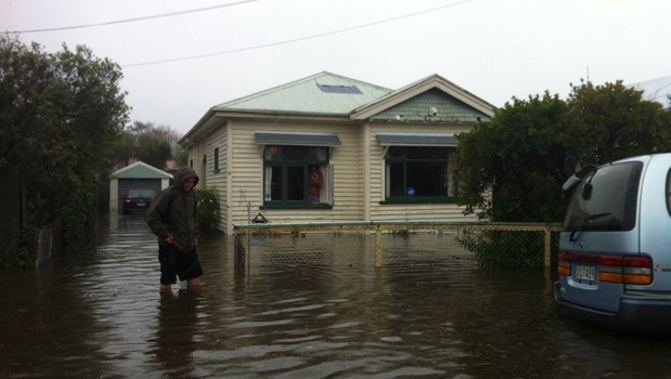
12 months ago who could say what or where the Flockton Basin was? Every year new words get added to the world's conversational dictionary, but I can think of few that have become so quickly ingrained in New Zealand's vocabulary than the home of Canterbury's constant flooding problems. For me the words “Flockton Basin” conjure an immediate mental image, streets turned to rivers, submerged cars, and residents trudging around in rain-coats trying desperately to protect their houses. For those residents living in Flockton however, their frustration extends far beyond the water that lapped at their properties. Their problems don’t end as the water subsides; and 2014 will always be for them, the year they amateur experts of insurance policy, on liability and masters of being patient.
The “one in a one-hundred year” weather event hit Christchurch in early March. 150mm of rain was recorded in 24 hours, 4600 lost power and the Avon and Heathcote Rivers breached their banks before breakfast. It was always going to bad in Flockton, a flood the previous year had shown just what an impact the earthquake had on the land. The council even took the time to ring residents the night before the heavy rain was expected, warning them flood water was likely to reach floor level. But unlike the 2013 flood, which affected around 30 homes, this time whole streets turned into canals. Residents woke to water lapping at their beds; some evacuating their homes at 4am, taking with them what they could and moving valued possessions above the water line. The resilient smile so many Cantabrians were practiced in putting on was slowly starting to slip.
They didn’t have to wait long for the next historic flood. Already pummeled by the Easter storm that battered so much of the South Island, Flockton Basin really didn’t need any more rain in April. Many residents hadn’t returned home from the March flood, but spent much of their holiday weekend stacking sandbags around their property in a last ditch attempt to keep their carpet dry. The flood water reached knee height and then subsided. But less than a fortnight later the rain was back with a vengeance. Much heavier than forecast, 50 mm fell in 24 hours, and Flockton residents once again woke to flood water knocking on the doors. Drenched residents appeared on TV clearing up their homes, and one even door-stopped the prime minister during a press conference. While the damage wasn’t as bad as in March, the continual clean up had truly started to take its toll on residents, wading through knee high water through sewage and toilet paper was an almost weekly activity, and the mood was hopeless.
It’s staggering to think after three floods and millions of dollars in damage no decision had been made about how to deal with Flockton. The country was left in disbelief as continual images of the area submerged under water played on TV and dominated the front page of paper when there was no solution from the council or government. The problem is seemingly obvious, the low-lying land slumped lower following the Canterbury earthquakes; and by that logic those affected should be entitled to the same relief as those whose land was no longer stable, but that wasn’t too be. The idea of returning to their sodden homes and feeling anxious every time it rained was too much for many residents to face, and the suggestion of a “buy-out” offer was mooted; a new red-zone in the suburb of St Albans that would enable people to move out and move on if they wanted to.
However neither the government nor the city council supported the red zone idea, opting instead to hold out for an engineering solution. The obvious problem was- an engineered solution would take time; even fast tracked, authorities had to admit any engineered solution, whether it included widening water ways or pumping stations would take at least two years to implement. It was a length of time the council knew wouldn’t be acceptable, given the area had flooded to floor level at least three times before winter. To compensate, the council established a “flooding taskforce”, charged with finding short team solutions to Flockton’s flooding woes, while permanent solutions were developed. Many in Flockton had their fingers crossed their fingers crossed a report from the taskforce would include a buyout offer, and devastation set in when it wasn’t. A temporary pump station, river dredging and house water proofing were options being investigated by the task force, but with any option likely to take three months away from being operational it was cold comfort to residents facing a cold and wet winter.
Fortunately, the winter seemed to pass with minimal flooding threats to Flockton. Breath was collectively held during one downpour in June but hastily installed pumps on the Avon River appeared to do their job. However, the battle was far from over for those who owned homes in the basin. Disagreements over who was liable for the flood prone land left residents in limbo, unable to repair or move on. To determine whether it was responsible for land at an increased flooding vulnerability EQC asked for a declaratory judgment in the High Court. The Insurance Council, Southern Response and Flockton Group all joined the court proceedings to ensure the court had a wide pool of opinion to draw from. The public gallery was frequently full with Flockton residents throughout the four day hearing, many had becoming pseudo-experts on everything insurance related and could follow the complex legal discussions better than most. EQC had three main questions for the High whether it was liable for increased flooding vulnerability, how it should determine a property’s land is damaged and how the property owner is compensated. But the judge queried EQC’s motives, saying there’s no way the court can give the policy the rubber stamp, they weren’t legislators after all.
In December the judgement came back. EQC was been given the green light to settle thousands of land claims by paying out the loss of value to the land. The court determined that if a home has become more flood-prone because the land has subsided, it was a form of land damage only, and EQC will not pay out for building damage as a result of IFV. The High Court decision said EQC's guidelines for settling claims must require good faith, should not be applied mechanically, should not exclude relevant factors, entitle owners to provide further information and not stopping them taking EQC in court. The decision wasn’t what many residents had been hoping for, but they tried to take in their stride. Carrick Street resident Jo Byrne was pleased that at least there were now guidelines around transparency when it came to the land settlement process.
It’s unclear whether this year will be all go or woe for those in Flockton. The wheels are in motion for a settlement process for those in Flockton, and construction of a long term flooding prevention solution likely to get underway. Neither of those factors will be able to stop the heart racing fear of locals every time a heavy rainfall is predicted, but it is progress. They, like the rest of us can only wait with their fingers crossed that the clouds are kind and the pumps hold out. Hopefully they don’t have endure another flood like that for at least a “hundred” years.
Take your Radio, Podcasts and Music with you









